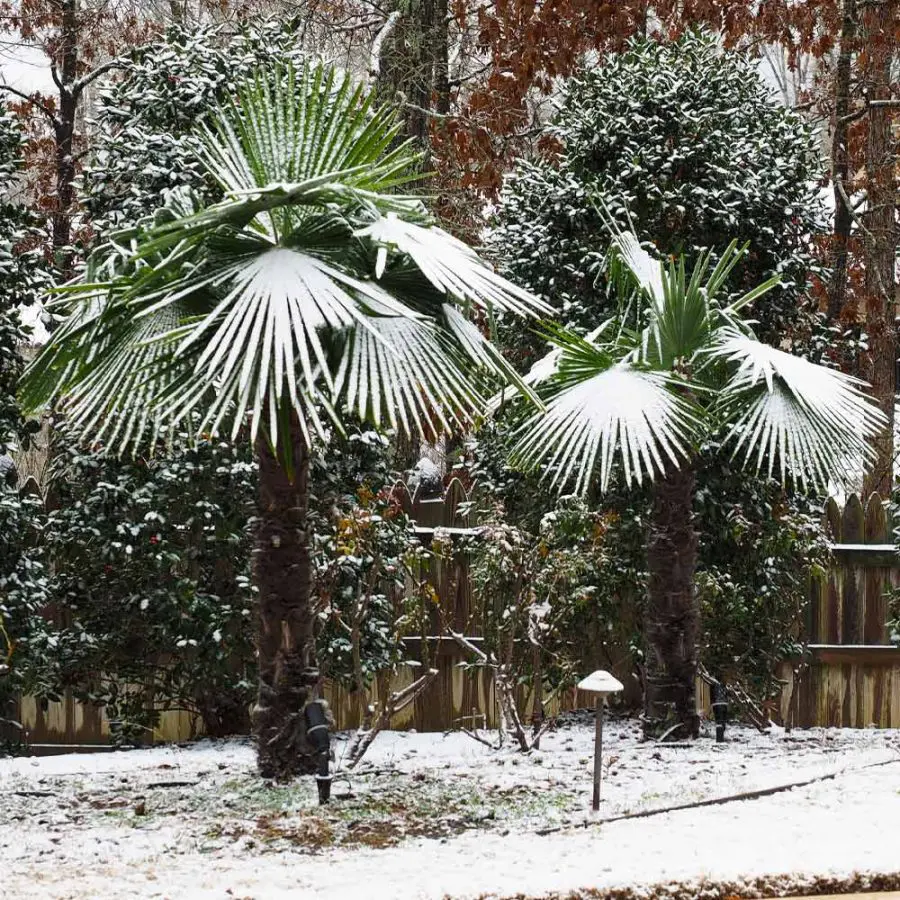This post contains affiliate links. If you buy something from one of our links we may earn a commission. Thanks
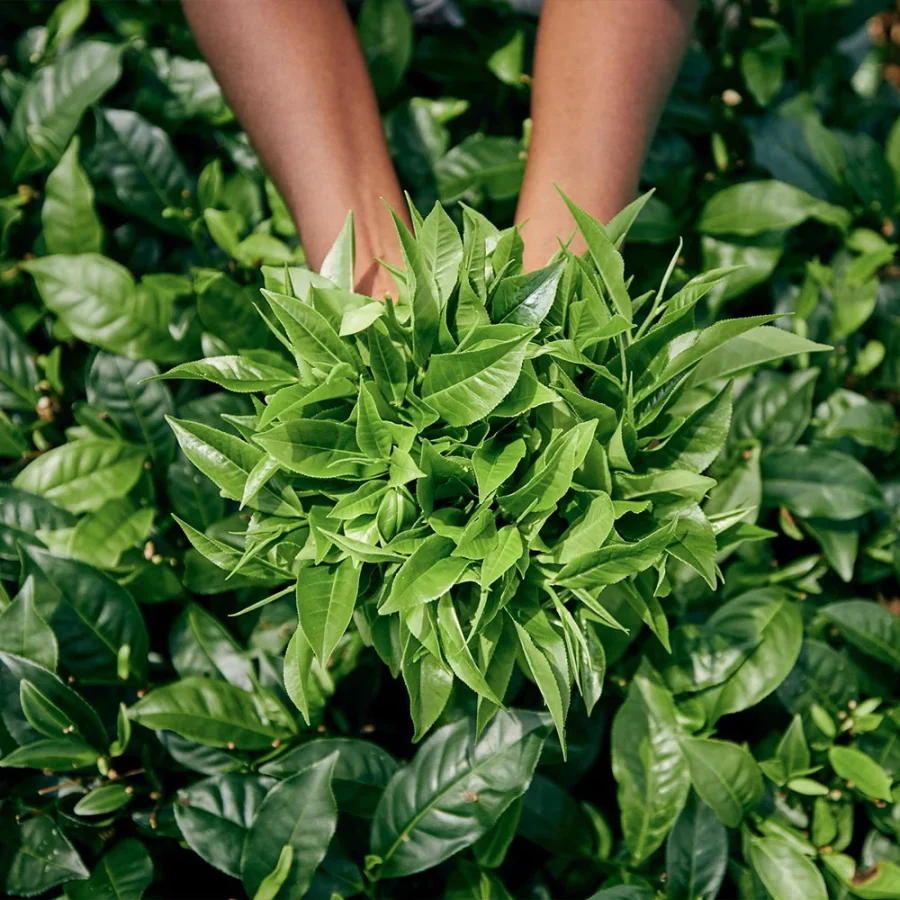
Looking to grow your own cold hardy tea plant? Our step-by-step guide has got you covered!
Grow your own Camellia sinensis cold hardy tea plant by planting seeds or saplings in a well-draining, acidic soil, preferably in a sunny, sheltered location.
Ensure to water it regularly, but avoid waterlogging. Protect the plant from extreme cold temperatures and fertilize it with a high-nitrogen fertilizer during the growing season for a lush, healthy tea plant.
Learn everything you need to know about how to grow a cold hardy tea plant.
Have you ever thought about growing your own tea plant but were discouraged by the cold weather?
Fear not, because we’ve got you covered! In this guide, we’ll show you how to grow a cold hardy tea plant and enjoy the fruits of your labor in no time.
I. Introduction To Growing Cold-Weather Tea Plants
Are you a tea lover looking to take your passion to the next level? Why not try growing your own cold-hardy tea plant?
It may sound daunting, but with the right information and some TLC, you can cultivate a beautiful and productive tea plant right in your own backyard.
In this guide, we will cover everything you need to know to get started, including selecting the right variety, choosing the best location, planting and caring for your tea plant, harvesting and processing your leaves, and even tips for growing tea indoors in pots.
So, let’s dive in and learn how to grow a cold-hardy tea plant!
What are Cold-Hardy Tea Plants?
Cold-hardy tea plants are tea varieties that can withstand cold temperatures and can grow in regions with colder climates.
These plants are different from the traditional tea plants that grow in warm, humid climates.
Cold-hardy tea plants are able to thrive in regions with harsh winters, making them a perfect addition to any home garden.
Get your cold hardy tea plant here:
Benefits of Growing Cold-Hardy Tea Plants
Growing cold-hardy tea plants has many benefits here are a few:
• It allows tea enthusiasts who live in colder climates to grow their own tea plants and enjoy fresh tea leaves.
• It is a sustainable way to source tea leaves, as you won’t need to rely on imported tea.
• Growing your own tea plants can be a fun and rewarding hobby that allows you to connect with nature.
Cold Hardy Tea Plants Quick Facts
| Mature Height: | 6-15 ft. |
| Mature Width: | 4-8 ft. |
| Sunlight: | Full Sun |
| Growth Rate: | slow |
| Botanical Name: | Camellia sinensis var. sinensis |
| Grows Well In Zones: | 4-11 patio / 7-9 outdoors |
How To Grow A Cold Hardy Tea Plant
Brief Overview of the Steps Involved in Growing Cold-Hardy Tea Plants
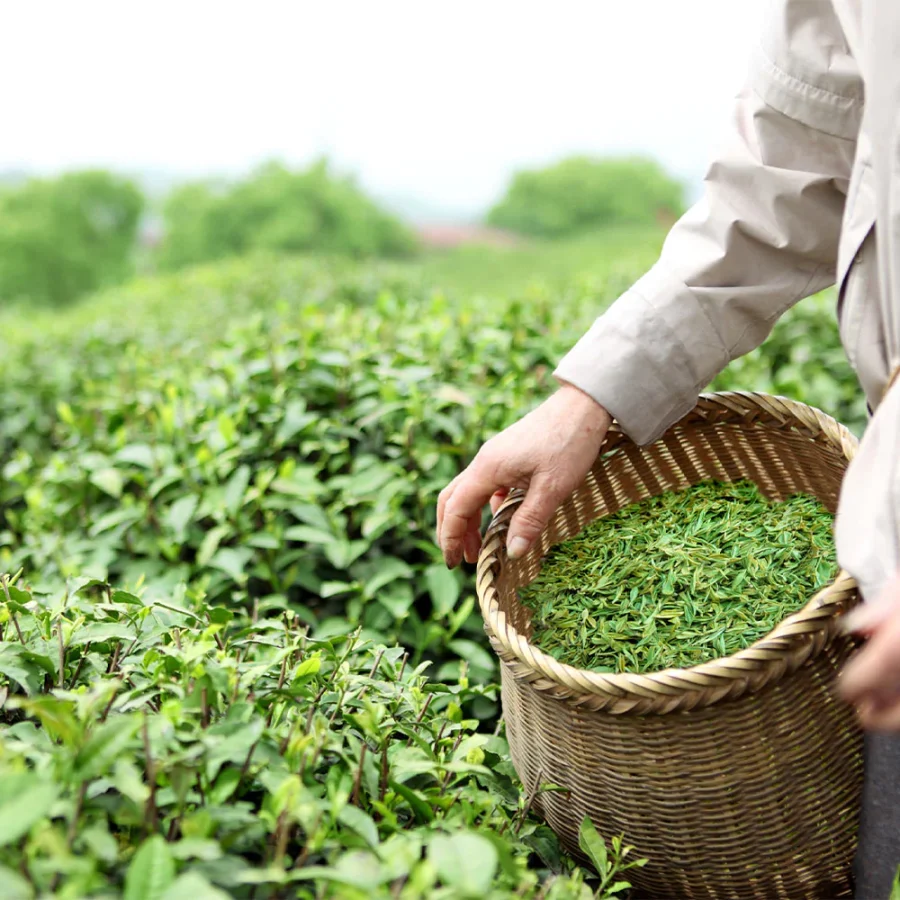
Growing cold-hardy tea plants involves several steps:
• You need to choose the right location for your tea plant.
• This involves selecting a spot that has the ideal climate, soil, sunlight, and shade conditions.
• You need to select the right tea plant variety that is suitable for your climate and soil conditions.
• You need to plant and care for your tea plant by preparing the planting site, watering and fertilizing the plant, pruning and shaping it, and protecting it from pests and diseases.
• You need to harvest and process your tea leaves by timing the harvest, withering and rolling the leaves, oxidizing and drying them, and storing and aging them.
With these steps in mind, growing cold-hardy tea plants can be a fun and fulfilling experience.
II. Choosing the right location for your tea plant
Choosing the right location for your tea plant is crucial for its growth and development.
In this section, we will provide you with all the information you need to select the ideal location for your cold-hardy tea plant.
We will discuss the climate conditions, soil requirements, and sunlight and shade preferences that will help your tea plant thrive.
By the end of this section, you’ll have the knowledge needed to choose the perfect spot for your tea plant to call home.
Ideal Climate Conditions for Cold-Hardy Tea Plants
Cold-hardy tea plants thrive in cooler climates, where the average temperature ranges between 10°C and 20°C.
The temperature range of 10°C to 20°C is equivalent to 50°F to 68°F in Fahrenheit.
These plants can tolerate frost and snow, but they require a warm period during the summer to grow and produce tea leaves.
Choose a location shielded from strong winds. It’s important to note that different varieties of tea plants have different temperature requirements, so it’s essential to select a variety that is suitable for your climate.
In much of the United States tea plants are hardy. Camellia sinensis, the tea plant, is typically hardy in USDA Zones 7-9.
However, some cultivars are more cold-tolerant and can be grown in USDA Zones 6-10. It’s important to choose the right cultivar for your climate and growing conditions to ensure the best chances of success.
If you live in a colder USDA zone, you may be able to grow tea in a greenhouse or other protected environment.
Soil Requirements for Cold-Hardy Tea Plants
Cold-hardy tea plants prefer well-drained soil that is rich in organic matter.
The ideal soil pH for tea plants is slightly acidic soil between 5.5 and 6.5. Tea plants also require soil that is high in nitrogen, phosphorus, and potassium.
If your soil is deficient in any of these nutrients, you can amend it with organic fertilizers or compost.
It’s important to note that tea plants are sensitive to soil salinity, so it’s essential to avoid planting them in areas with high salt levels.
Sunlight and Shade Requirements for Cold-Hardy Tea Plants
Cold-hardy tea plants require a balance of sunlight and shade to thrive.
In general, tea plants prefer partial shade, where they receive around 50% to 70% of full sunlight.
Tea plants that are exposed to only full sun may suffer from sunburn or heat stress, while those that are planted in deep shade may not produce as many tea leaves.
When selecting a spot for your tea plant, choose an area that receives partial shade during the hottest part of the day.
This will help your tea plant grow and produce the highest quality tea leaves.
III. Selecting the right tea plant variety
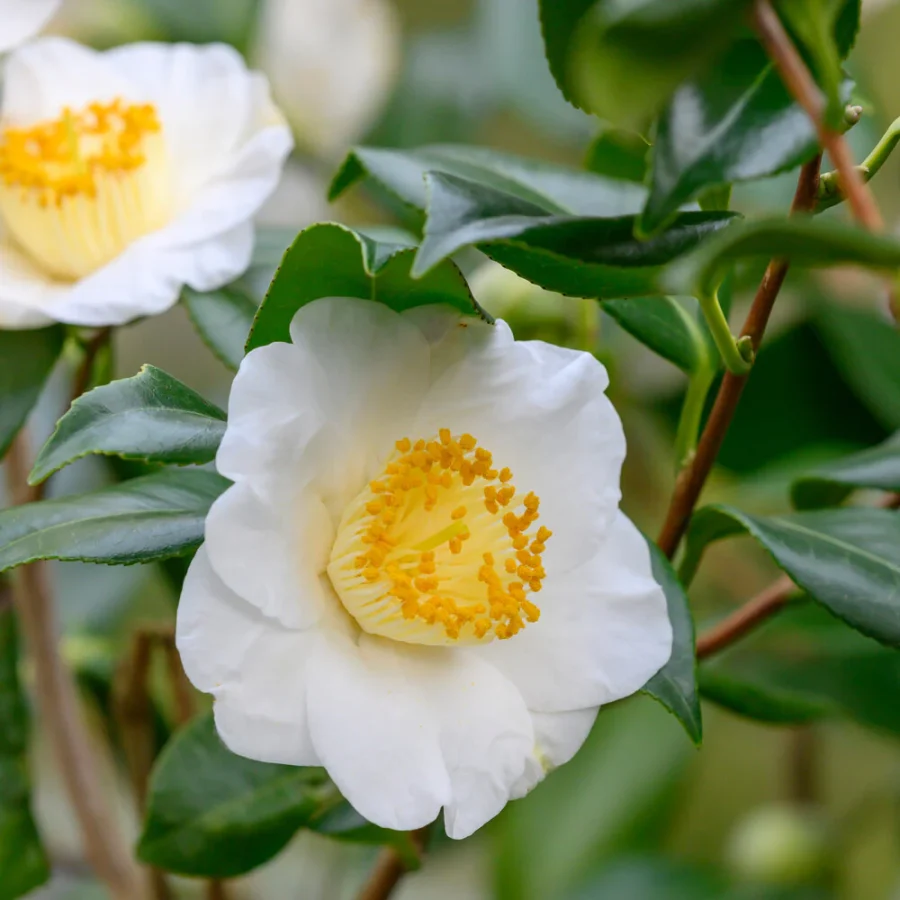
Choosing the right tea plant variety is essential for growing a successful cold-hardy tea plant.
In this section, we will discuss the different varieties of tea plants that are suitable for colder climates, and the characteristics that make them ideal for growing in these conditions.
We’ll cover aspects such as growth rate, yield, and flavor profiles, and provide you with the information you need to select the best tea plant variety for your needs.
By the end of this section, you’ll have a good understanding of the different tea plant varieties and be ready to choose the perfect one for your garden.
Choosing the right variety for your climate and soil conditions
Choosing the right variety of tea plants for your specific climate and soil conditions is critical to growing a successful cold-hardy tea plant.
When selecting a variety, consider the temperature range and soil requirements that are ideal for the subspecies of Camellia sinensis var that you are interested in growing.
Here are some factors to consider:
Climate: As we mentioned earlier, different varieties of Camellia sinensis have different temperature requirements.
For example, Camellia sinensis sinensis prefers cooler temperatures than Camellia sinensis assamica.
Make sure to select a variety that is well-suited for the temperature range in your region.
Soil: Camellia sinensis prefers well-draining soil that is rich in organic matter, and has a pH range between 5.5 and 6.5.
When selecting a variety, consider the soil characteristics in your area, such as the texture, nutrient levels, and drainage.
Growth habits: Some varieties of Camellia sinensis are better suited for growing in pots, while others are more suitable for planting directly in the ground.
Consider the growth habits of the variety you are interested in, and choose one that fits your specific growing conditions.
By taking these factors into consideration, you can select a variety of Camellia sinensis that is well-suited for your specific climate and soil conditions.
With the right variety, you’ll be on your way to growing a healthy and productive cold-hardy tea plant.
Camellia sinensis variety
Camellia sinensis is the primary variety of tea plants that are used to produce most of the world’s tea.
There are two main subspecies of Camellia sinensis: Camellia sinensis sinensis and Camellia sinensis assamica.
Both subspecies can be grown in cold-hardy regions, but they have different characteristics that may make one more suitable for your needs than the other.
Camellia sinensis sinensis is the subspecies that is most commonly grown in China and other parts of Asia.
It has a slower growth rate than Camellia sinensis assamica, but it produces high-quality tea leaves with delicate flavors and aromas.
This variety of tea plant prefers cooler temperatures and partial shade, making it ideal for growing in colder climates.
Camellia sinensis assamica, on the other hand, has a faster growth rate than Camellia sinensis sinensis, and it produces larger leaves that are ideal for making black tea.
This variety of tea plant is commonly grown in India and other parts of South Asia, where the climate is warmer and more humid.
However, it can also be grown in colder regions with proper care and maintenance.
Overall, both subspecies of Camellia sinensis can be grown in cold-hardy regions, and the variety you choose will depend on your personal preferences and needs.
If you’re looking to grow a cold-hardy tea plant in a pot, there are several varieties of Camellia sinensis that are well-suited for container gardening. Here are a few options to consider:
‘Sochi’ tea plant: This variety is a cold-hardy cultivar that is ideal for growing in containers. It has a compact growth habit and produces delicate, flavorful leaves.
‘Rosea’ tea plant: This variety is a beautiful option for container gardening, as it produces pink flowers in addition to flavorful tea leaves. ‘Rosea’ is a cold-hardy cultivar that is known for its compact growth habit.
When selecting a variety of tea plant for container gardening, consider factors such as growth rate, leaf size, and overall size of the plant.
Choose a variety that is well-suited for the size of your container and your specific growing conditions.
With the right variety, you can enjoy the flavors and benefits of cold-hardy tea plants right from your own patio or balcony.
IV. Planting and caring for your tea plant
Congratulations on choosing the perfect location and variety for your cold-hardy tea plant!
Now that you have everything in place, it’s time to get your plant in the ground and start caring for it.
Planting and caring for your tea plant may seem daunting at first, but with a few simple steps, you can ensure that your plant thrives and produces delicious tea leaves.
In this section, we’ll cover everything you need to know about planting and caring for your tea plant, from preparing the soil to fertilizing and watering.
So grab your gardening gloves and let’s get started!
Preparing the planting site
Before you start planting your tea plant, it’s important to prepare the site properly.
Choose an area with well-draining soil that receives partial shade throughout the day.
Clear the area of any weeds or debris, and mix in some organic matter like compost or aged manure to help improve the soil’s fertility.
Planting your tea plant
Once your planting site is ready, it’s time to get your tea plant in the ground.
Dig a hole that is twice as wide and just as deep as the root ball of your plant.
Gently remove the plant from its container and loosen any tangled roots.
Place the plant in the hole and backfill it with soil, making sure to tamp down gently to remove any air pockets.
Watering and fertilizing your tea plant
After planting, make sure to water your tea plant regularly to help it establish its roots.
Depending on the size of your plant, and soil type you may need to water it every day or every other day to get it established.
It’s also important to fertilize your tea plant regularly to help it grow strong and healthy.
Use a balanced fertilizer every four to six weeks during the growing season.
Pruning and shaping your tea plant
Regular pruning is essential for maintaining the shape and health of your tea plant.
Prune your plant in the late winter or early spring before new growth begins.
Remove any dead or damaged branches, and shape the plant to your desired size and shape.
Always cut back to a leaf node when you prune.
Protecting your tea plant from pests and diseases
Like any plant, tea plants can be vulnerable to pests and diseases.
Keep an eye out for common issues like spider mites, aphids, and scale insects, and treat them promptly with insecticidal soap or neem oil.
It’s also important to keep your tea plant well-ventilated to prevent fungal diseases like black spot and powdery mildew.
By following these simple steps, you can help ensure that your tea plant stays healthy and productive for years to come.
Growing Tea Indoors in Pots:
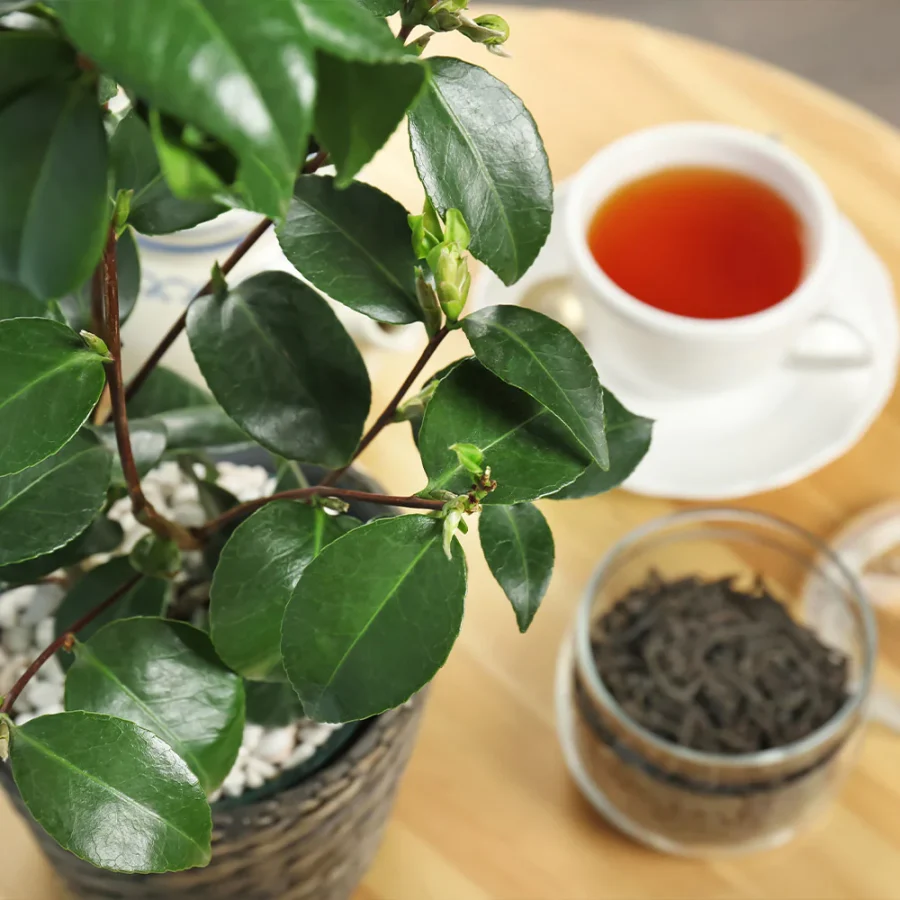
If you don’t have access to a suitable outdoor space for growing cold-hardy tea plants, you can still enjoy the benefits of home-grown tea by growing tea plants in pots indoors as a small tree or tea shrub.
Here are some tips for growing tea plants in pots:
Choose a suitable variety: Select a variety of tea plant that is well-suited to growing in pots, such as Camellia sinensis sinensis, which is a smaller and more compact variety of tea plant.
Use the right soil: Use a well-draining potting mix with a pH level of around 6.0-6.5, which is a slightly acid soil and ideal for tea plants. Use large containers that accommodate the root ball without crowding it and allow the plant to become a large shrub.
Provide the right lighting: Tea plants require bright, indirect light, so place them near a window that receives plenty of natural light, or use artificial grow lights if necessary.
Water and fertilize regularly: Keep the soil moist but not waterlogged, and fertilize your tea plant every two weeks during the growing season with a balanced, water-soluble fertilizer.
Overwatering can result in root rot so only water after the soil surface has had a chance to dry out.
Prune regularly: Tea plants benefit from regular pruning to keep them in a compact and bushy shape.
Prune them back by about one-third of their size after the growing season has ended, and remove any dead or damaged branches as needed.
With these tips, you can successfully grow a tea plant in a pot indoors and enjoy the experience of growing and harvesting your own tea leaves.
Just be sure to do your research and follow the care instructions carefully to ensure the best results.
V. Harvesting and processing your tea leaves
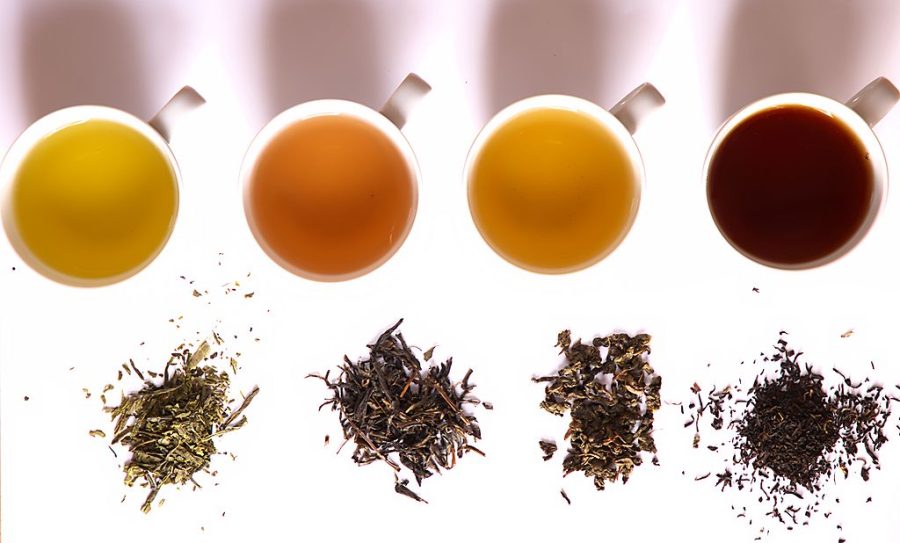
Congratulations! You’ve successfully grown your very own cold-hardy tea plant, and now it’s time to harvest and process your tea leaves.
Harvesting and processing your tea leaves may seem intimidating at first, but with a little bit of know-how, you’ll be able to create delicious, homemade tea that you can enjoy year-round.
In this section, we’ll cover everything you need to know about harvesting and processing your tea leaves, from when to pick them to how to dry and store them properly.
So put the kettle on, grab a few friends, or tea fanatics, and let’s get started!
Timing the harvest
Timing is everything when it comes to harvesting tea leaves.
For the best flavor and aroma, you’ll want to pick your tea leaves at the optimal time, which will depend on the variety of tea plant you’re growing and the weather conditions in your area.
Different harvest times and processing methods result in different tea tastes.
In general, you’ll want to harvest your tea leaves in the late spring or early summer, when the new growth is tender and flavorful.
Harvesting your tea leaves
When it comes time to harvest your tea leaves, you’ll want to use a sharp pair of scissors or pruning shears to carefully snip off the top two leaves and the buds of individual branches.
Be sure to pick only the new growth and leave the older leaves on the plant to continue photosynthesizing and producing energy for the plant.
Withering and rolling your tea leaves
After you’ve harvested your tea leaves, you’ll need to wither them to remove some of the moisture and make them more pliable for rolling.
Spread your tea leaves out in a thin layer on a clean, dry surface, and let them wither for a few hours, or until they start to wilt.
Next, you’ll need to roll your tea leaves to break down the cell walls and release the tea’s natural flavors and aromas.
You can do this by hand, or by using a rolling machine.
Oxidizing and drying your tea leaves
Once you’ve rolled your tea leaves, you’ll need to allow them to oxidize.
This process involves exposing the tea leaves to oxygen, which will cause them to turn brown and develop their characteristic flavors and aromas.
The length of time you allow your tea leaves to oxidize will depend on the type of tea you’re making but generally ranges from a few hours to a full day.
After your tea leaves have oxidized, you’ll need to dry them to halt the oxidation process and remove any remaining moisture.
You can do this in different ways by laying your tea leaves out in a thin layer on a clean, dry surface, or by using a dehydrator or oven set to a low temperature.
Storing and aging your tea leaves
Once your tea leaves are dry, it’s time to store them properly to preserve their flavor and aroma.
Store your tea leaves in an airtight container in a cool dry area away from light, moisture, and strong odors.
If you want to age your tea, you can store it for several months or even years to allow the flavors and aromas to mellow and deepen.
Just be sure to check on your tea periodically and discard any leaves that show signs of mold or spoilage.
Green Tea
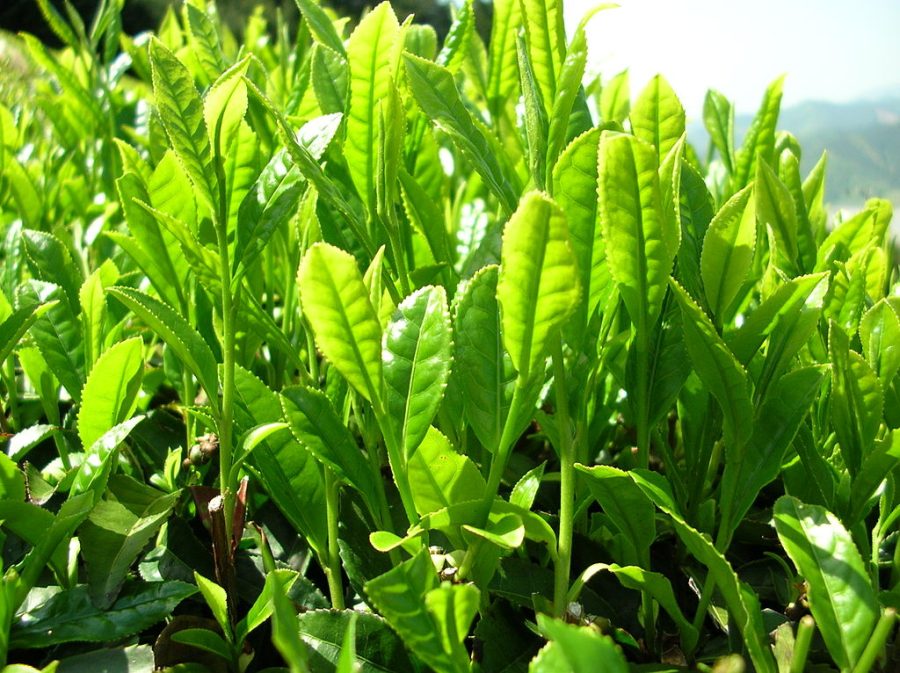
Green tea is not typically oxidized, as it is made from unoxidized tea leaves.
Instead, after the leaves have been harvested and withered, they are pan-fried or steamed to stop any oxidation from occurring.
After being pan-fried or steamed, the leaves are typically rolled to shape them and then dried to remove any remaining moisture.
The drying process can take several hours and may be done by machine or hand.
Overall, the processing of green tea is quite different from that of black tea or oolong tea, which do undergo oxidation.
What is white tea?
White tea is a type of tea that is known for its delicate flavor and light color.
It is made from the young leaves and buds of the Camellia sinensis plant, which are carefully harvested and then quickly dried to prevent oxidation.
This minimal processing gives white tea its unique and subtle flavor profile, which is often described as sweet, floral, and slightly earthy.
White tea is also known for its high antioxidant content, making it a popular choice for those seeking a healthful and refreshing beverage.
Is it similar to green tea?
White tea and green tea come from the same plant, Camellia sinensis, but they undergo different processing methods.
While white tea is minimally processed and made from the young leaves and buds of the tea plant, green tea is made from more mature leaves that are steamed or pan-fired to stop oxidation.
This process gives green tea a slightly stronger taste and a different color than white tea.
However, both white and green teas are known for their delicate and nuanced flavor profiles, as well as their potential health benefits.
How to pick and process leaves for white tea
To make white tea, the young leaves, and buds of the Camellia sinensis plant are handpicked during a very specific time of the year, usually in early spring.
The leaves are carefully harvested when they are still covered in fine white hairs, giving white tea its name.
After harvesting, the leaves are quickly withered to remove excess moisture and then gently dried.
Unlike green tea, white tea is not steamed or pan-fired, and the leaves are not rolled or shaped during processing.
Instead, the leaves are dried slowly and naturally in the sun or in a low-temperature oven, allowing the tea to maintain its delicate flavor and appearance.
The minimal processing of white tea means that it retains many of its natural antioxidants and other health-promoting compounds.
However, because it is made from young and delicate leaves, white tea can be more expensive than other types of tea.
It is also more susceptible to damage during processing, which can affect the final flavor and quality of the tea.
As a result, making high-quality white tea requires careful attention to detail and skillful processing techniques.
VI. Cold Hardy Tea Plant FAQs
Cultivating your own Camellia sinensis cold hardy tea plant can be a rewarding experience as you nurture it from a seedling to a flourishing plant.
However, there are common inquiries that gardeners have when embarking on this journey.
Here are some of the queries answered to help you on your way:
Q. What is the ideal location for planting my Camellia sinensis plant?
A. A sunny, sheltered spot with well-draining, acidic soil is ideal for your Camellia sinensis plant.
Q. How often should I water my Camellia sinensis plant?
A. Watering should be regular to keep the soil moist, especially in the first year, but avoid waterlogging as it can lead to root rot.
Q. When is the best time to harvest leaves from my Camellia sinensis plant?
A. The best time to harvest is when the leaves are young and tender, typically in spring and early summer.
Q. What kind of fertilizer is suitable for Camellia sinensis plants?
A. A high-nitrogen fertilizer is suitable, and it’s advisable to fertilize during the growing season to encourage lush growth.
VII. How To Grow A Cold Hardy Tea Plant Final Thoughts
Congratulations! By now you should have a good understanding of how to grow your own cold hardy tea plant and even harvest and process your own tea leaves.
Growing tea can be a rewarding and satisfying experience, as you not only get to enjoy the delicious taste of your own homegrown tea, but also the satisfaction of having grown it yourself.
With a little bit of knowledge and effort, you can easily cultivate your very own tea plant and start enjoying the fruits of your labor in no time. Happy growing and sipping!
Recap of the steps involved in growing cold-hardy tea plants:
Choose the right location for your tea plant, with the ideal climate, soil, sunlight, and shade conditions.
Select the right variety for your climate and soil conditions, such as Camellia sinensis or another variety suitable for pots.
Plant and care for your tea plant, including preparing the planting site, planting the tea plant, watering and fertilizing it, pruning and shaping it, and protecting it from pests and diseases.
Harvest and process your tea leaves, including timing the harvest, harvesting the leaves, withering and rolling them, and oxidizing and drying them.
Final recommendations:
Remember to always use high-quality tea leaves for the best results.
Don’t be afraid to experiment with different processing techniques to find the flavor and aroma that you enjoy most.
Consider joining a tea-growing or tea-tasting group to connect with other tea enthusiasts and learn more about the world of tea.
Encouragement to try growing your own cold-hardy tea plant:
Growing your own tea plant can be a fun and rewarding experience, and you don’t need to be an expert gardener to do it.
With a little bit of research and effort, anyone can grow their own tea and enjoy the delicious taste of freshly brewed, home-grown tea.
So why not give it a try and see where your tea-growing journey takes you?
Get your cold hardy tea plant here:
Get more backyard gardening ideas




